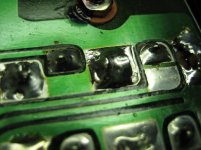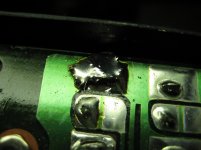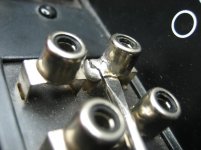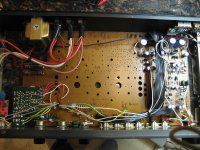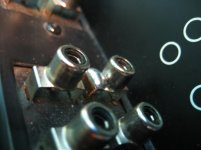Hi. I haven't posted here often but this seems the most likely forum where someone may comprehend this. Could also be that I'm missing something blatantly obvious so if so, apologies for my ignorance.
I purchased a NAD 1020a preamplifier last week with what I thought was just a minor defect with the stereo/mono switch which after cleaning, functions again as it should. However, only one channel is fully functional on the Phono input. Tape in works fine so I concluded the problem must be within the Phono pre-amp section.
Using Phono, the Right channel is good but the Left is quite weak. I swapped sides of the interconnects and the weak channel became the Right and the good channel was then the Left. Seemed like a bad cable so I used a different pair but got the same thing. Although unlikely, I thought perhaps the second set of interconnects was also faulty so I tried a 3rd but they too produced the same result.
Logic now dictated to me that the problem must be within the turntable so I used a different one but again, same thing.
May or may not be relevant but the normal and weak channels are reversed regardless if I switch sides of the cable at the Phono input jacks of the 1020a or at the turntable output jacks.
This has really got me scratching my head.
Does anyone have an opinion on why both channels of the Phono pre-amp will not work together simultaneously but are fine independently?
I purchased a NAD 1020a preamplifier last week with what I thought was just a minor defect with the stereo/mono switch which after cleaning, functions again as it should. However, only one channel is fully functional on the Phono input. Tape in works fine so I concluded the problem must be within the Phono pre-amp section.
Using Phono, the Right channel is good but the Left is quite weak. I swapped sides of the interconnects and the weak channel became the Right and the good channel was then the Left. Seemed like a bad cable so I used a different pair but got the same thing. Although unlikely, I thought perhaps the second set of interconnects was also faulty so I tried a 3rd but they too produced the same result.
Logic now dictated to me that the problem must be within the turntable so I used a different one but again, same thing.
May or may not be relevant but the normal and weak channels are reversed regardless if I switch sides of the cable at the Phono input jacks of the 1020a or at the turntable output jacks.
This has really got me scratching my head.
Does anyone have an opinion on why both channels of the Phono pre-amp will not work together simultaneously but are fine independently?
Does anyone have an opinion on why both channels of the Phono pre-amp will not work together
simultaneously but are fine independently?
If the L and R phono input plugs touch each other when both are inserted, that could make a bad contact.
The phono circuit is fine if the channels work independently. Can you post a photo of the back, and the inside back?
If the L and R phono input plugs touch each other when both are inserted, that could make a bad contact.
The phono circuit is fine if the channels work independently. Can you post a photo of the back, and the inside back?
I'll do that but I'm just out the door for some errands and was about to shut down my computer.
Thanks for the reply and I'll be back in a few hours to examine the section of the board where the jacks attach. Will post some pictures unless there is a Eureka! moment and if so, I will advise.
Hi,
Your logic defeats all possible analysis. Basically it all cannot be true.
Try connecting L + R in together for a mono input, what is the result ?
rgds, sreten.
Your logic defeats all possible analysis. Basically it all cannot be true.
Try connecting L + R in together for a mono input, what is the result ?
rgds, sreten.
I'm with sreten that it does defeat reasonable analysis. Probably one one of those things where you 'gotta be there to see what it does.
Hazy thinking... cracked ground on the input sockets and some weird phase cancellation occurring depending on content.
Hazy thinking... cracked ground on the input sockets and some weird phase cancellation occurring depending on content.
Connect one channel at a time to start with.
Hi,
That will do for the 4 cases before the 1 parallel case.
rgds, sreten.
Also note mono/stereo is either pretape or post
tape but very unlikely to be both, which is it ?
Or is it both ?
Last edited:
It was one of those Eureka! moments - sort of. And it looks like Mooly nailed it.
This thing has those vertically mounted input jacks that are supported only by their solder connection to the PC board. Some previous owner pushed down way too hard, I guess when plugging in their turntable and in so doing, lifted the ground pads off the traces. Close inspection makes me think the solder was reflowed once before to repair but it failed to provide any extra holding power.
The attached photos of the Phono In jacks are "afters" (except the broken main pre out jack), I did not think to take any "befores".
I laid a little braided solder wick over top of the worst broken connection and liberally applied new solder. Seems to have done the trick, at least for now.
Although it functioned, I also found similar damage to a main pre-out jack. Worse actually because whoever connected their power amp not only lifted pads from traces but broke the external metal portion of the barrel that takes all the stress. A solder repair was attempted but it has obviously failed. I am thinking about a way to repair/re-inforce it because my intention was to pair this with a power amp I have and offer both for sale.
There sure is lot of room inside these things. Looks like they quit building while on the way to a 3020.
This thing has those vertically mounted input jacks that are supported only by their solder connection to the PC board. Some previous owner pushed down way too hard, I guess when plugging in their turntable and in so doing, lifted the ground pads off the traces. Close inspection makes me think the solder was reflowed once before to repair but it failed to provide any extra holding power.
The attached photos of the Phono In jacks are "afters" (except the broken main pre out jack), I did not think to take any "befores".
I laid a little braided solder wick over top of the worst broken connection and liberally applied new solder. Seems to have done the trick, at least for now.
Although it functioned, I also found similar damage to a main pre-out jack. Worse actually because whoever connected their power amp not only lifted pads from traces but broke the external metal portion of the barrel that takes all the stress. A solder repair was attempted but it has obviously failed. I am thinking about a way to repair/re-inforce it because my intention was to pair this with a power amp I have and offer both for sale.
There sure is lot of room inside these things. Looks like they quit building while on the way to a 3020.
Attachments
There sure is lot of room inside these things. Looks like they quit building while on the way to a 3020.
IIRC, it's the same board and box, with a different face plate for the 3020. I've had both, and fortunately didn't have any problems with the RCA's, although it was an issue back in the day.
jeff
Ah, good ol' NAD engineering! It keeps on baffling users decades after the use-by date 😉
The near empty board is an inexpensive way to develop and manufacture lower volume items like preamps for the budget market. Just omit the power amplifier sections and speaker related features, fit a smaller power supply and rework the rear panel of an integrated amplifier - add a simple feature or two.....voila!
SEVENTIES STEREO: NAD 1020 Preamp Photos
NAD probably didn't figure that people who preferred the sound quality of their early super-cheap designs over more expensive gear would also expect similar durability as part of the deal. Sadly, it doesn't work out like that but I imagine you are now aware of the pitfalls in NAD's product philosophy.
The near empty board is an inexpensive way to develop and manufacture lower volume items like preamps for the budget market. Just omit the power amplifier sections and speaker related features, fit a smaller power supply and rework the rear panel of an integrated amplifier - add a simple feature or two.....voila!
SEVENTIES STEREO: NAD 1020 Preamp Photos
NAD probably didn't figure that people who preferred the sound quality of their early super-cheap designs over more expensive gear would also expect similar durability as part of the deal. Sadly, it doesn't work out like that but I imagine you are now aware of the pitfalls in NAD's product philosophy.
Good stuff 🙂 I think the braid should be fine. What I would do is scrape the print for some way around the connections and use the braid method. The second picture, top right connection has that classic ready to fail look to it... in the picture it looks as though the solder is cracked most of the way around.
Thanks for pointing that out. Looks like a picture says more than in the flesh because it looked fine first hand. I did do some scraping around the connections I did repair and will do so again
I made a repair to the broken main output jack. I used a small piece of copper sheeting (used for architectural roofing) cut to size and bent at 90 degrees. There was no way I could have soldered it onto the inside of the jack so it went on the outside. Had to use a lot of solder, but it's holding (again, at least for now) and despite its crude appearance, an RCA plug fits onto it fine.
This process reminded me of an incident around 2003 that took place in an audio store I worked at. One of the salespeople sold one of those expensive Bose Lifestyle systems ($3200 or $3600 CDN) and along with it, some expensive cables. The customer was back the next day claiming he could not get the cables off because the RCA plugs were so tight. The salesperson gave it a try and the result was input jacks being pulled out by the roots.
I made a repair to the broken main output jack. I used a small piece of copper sheeting (used for architectural roofing) cut to size and bent at 90 degrees. There was no way I could have soldered it onto the inside of the jack so it went on the outside. Had to use a lot of solder, but it's holding (again, at least for now) and despite its crude appearance, an RCA plug fits onto it fine.
This process reminded me of an incident around 2003 that took place in an audio store I worked at. One of the salespeople sold one of those expensive Bose Lifestyle systems ($3200 or $3600 CDN) and along with it, some expensive cables. The customer was back the next day claiming he could not get the cables off because the RCA plugs were so tight. The salesperson gave it a try and the result was input jacks being pulled out by the roots.
Attachments
Thanks for pointing that out. Looks like a picture says more than in the flesh because it looked fine first hand.
As an ex bench tech I can usually spot a dry from a 100 paces 😉
I can just imagine the Bose (lol) and the look on faces in the shop when that happened. Some RCA plugs can be fiendishly tight though, I remember some Chord cables I once splashed out on at a show (the one and only time I indulged in 'cables') and how tight the things were. Still got them, still in use, in fact I'm listening through them now, and the plugs are still super tight after 20+ years or more.
I looked more closely and found several places where the jacks were partially lifted from the board. I guess the previous owner was a little ham fisted. Re-soldered them all so it's good to go.
It surprised me a little that the shop it came from sold it to me for $10. But I guess they thought it was not worth paying a tech an hour's time to fix something they may only get $100 for in working shape.
It surprised me a little that the shop it came from sold it to me for $10. But I guess they thought it was not worth paying a tech an hour's time to fix something they may only get $100 for in working shape.
- Status
- Not open for further replies.
- Home
- Amplifiers
- Solid State
- Strange problem with NAD 1020a pre-amp
